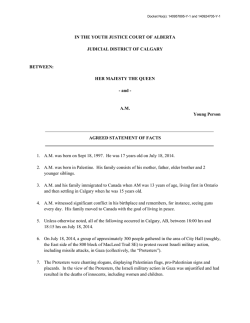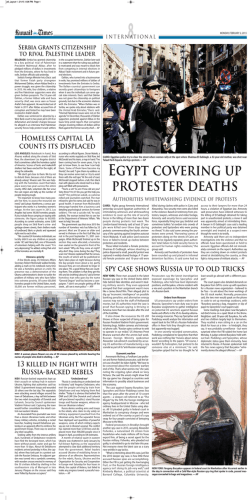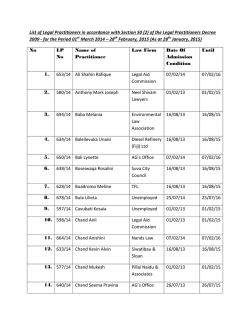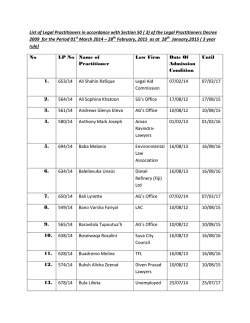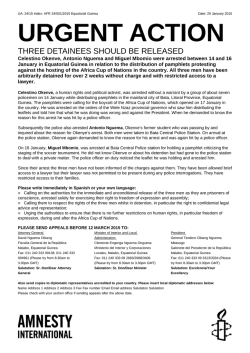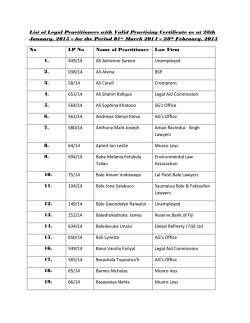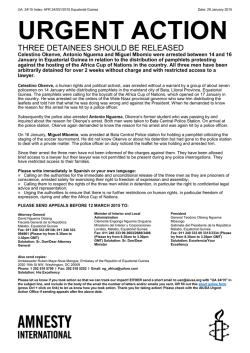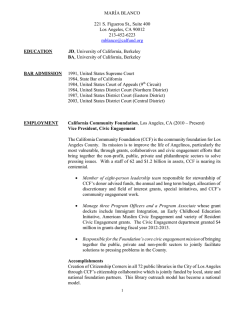
PDF - Amnesty International
Amnesty International Public Statement AI Index: MDE 12/005/2015 1 February 2015 Embargoed until 00:01 Sunday 1 February Egypt ‘covering up’ protester deaths in fourth anniversary of ‘25 January Revolution’ Egypt’s authorities are trying to cover up the deaths of more than two dozen people killed in protests marking the 2011 uprising, Amnesty International has warned today. Against the backdrop of a government smear campaign against protesters, Amnesty International has gathered information on prosecutors threatening eyewitnesses with arrest and security forces detaining at least two journalists for their coverage of the protests – as well as holding at least 500 demonstrators and bystanders in unofficial detention centres. Official investigations ordered into the killings appear aimed at whitewashing mounting evidence of the security forces’ ruthless and unlawful actions, Amnesty International has said. Security forces repeatedly used excessive force to disperse demonstrations between 23-26 January, or else failed to intervene in clashes between residents and protestors to stop the violence, Amnesty International’s research found. Some protests became violent, with a few individuals firing live ammunition. There were also a number of bombings across the country, particularly in Cairo, Alexandria and North Sinai. At least 27 people died in the violence, according to information available to Amnesty International. They include at least two women, Sondos Reda Abu Bakr and Shaimaa AlSabbagh, as well as a 10-year-old boy, Mina Maher. Two members of the security forces also died in clashes with protesters, the Interior Ministry has said. Amnesty International found that security forces repeatedly fired tear gas, shotguns, and occasionally other firearms at random into crowds of protesters and bystanders who were posing no threat. In other instances the security forces waited for several hours before intervening to stop the violence between protestors and residents, leading to several deaths. Security forces failed to take control of the situation or to respond to violence in a proportionate manner. The presence of armed individuals among protesters does not allow security forces to shoot randomly. The Egyptian authorities must make clear that excessive use of force and firearms will not be tolerated. They must ensure that security forces fulfil their duty to protect all Egyptians from violence regardless of their political affiliation. Amnesty International has reviewed testimonies from protesters, eyewitnesses and human rights lawyers, as well as video footage and photographs of the protests – including the shocking footage of the deaths of Shaimaa Al-Sabbagh in central Cairo on 24 January and Mina Maher on 25 January in the Cairo neighbourhood of Ain Shams. In recent days, Egypt’s government has hit back at criticism of their actions, pointing to investigations ordered into the violence by the public prosecutor. However, even as they are promising independent investigations, the authorities are scrambling to cover-up the security forces’ actions, Amnesty International has found. In a statement on 26 January, the interior minister flatly denied accusations that his forces had fired on peaceful protesters and claimed the demonstrations were the work of the Muslim Brotherhood, which he said was intent on causing “chaos”. Security forces are meanwhile holding at least 500 people across the country, according to the minister of interior. The minister has accused all of them of being supporters of “the Muslim Brotherhood terrorist group”. NGOs are aware of at least 200 protesters and bystanders who were arrested and held in Cairo in riot police camps at the edge of the city – which Egyptian law does not recognize as official places of detention and which are not under judicial oversight. The detained include at least one woman, nine children and two disabled persons. The police are also detaining at least two journalists who were documenting the protests, an Egyptian human rights organization told Amnesty International. Prosecutors have refused to disclose where the detained protesters were being held and have blocked attempts by some human rights lawyers to represent the detainees or to file complaints for enforced disappearance. Lawyers told Amnesty International that some were tortured during investigations by intelligence services. A prosecutor also ordered the arrest of eyewitnesses to Shaimaa Al-Sabbagh’s killing who had come forward to testify about what they had seen, in a move apparently aimed at intimidating eyewitnesses against testifying against the police. Official investigations into the killings are relying entirely on police witnesses and reports by the security forces and intelligence agencies, human rights lawyers have told Amnesty International. The Egyptian authorities have long proved unwilling or incapable of delivering independent and impartial investigations into human rights violations. Despite the deaths of hundreds of protesters at the hands of the security forces since July 2013, investigations have yet to hold the security forces or government officials to account. Former president Hosni Mubarak and his interior minister, Habib El Adly were cleared last November of charges of killing hundreds of protestors during the January 2011 uprising. The authorities have taken no action to rein in the security forces, despite the frequency and mass scale of the abuses they have been committing, particularly in policing protests. In fact, by enacting the November 2013 Protest Law, they have given the green light for such violations to continue with impunity. Harrowing scenes of protesters dying on the streets of Cairo are likely to be regularly repeated, given the authorities’ total failure to hold security forces to account for human rights violations. Robust action is now needed by the international community to address the mounting death toll and human rights crisis in Egypt. Amnesty International has urged the USA and EU to continue to freeze deliveries of arms and equipment that may facilitate human rights violations by the security forces. Months of silence on Egypt at the UN Human Rights Council have also emboldened the authorities to commit human rights violations on an unprecedented scale. Member states must act to hold the Egyptian authorities to account for widespread human rights violations. The Egyptian authorities must immediately and unconditionally release all those who are detained solely for peacefully exercising their rights to freedom of expression or assembly. They must conduct prompt, independent and impartial investigations into the political violence in which protesters, bystanders and residents were killed and injured in order to establish individuals who are responsible and ensure their prosecution in fair trials, without recourse to the death penalty. Cases Alexandria, 23 January Sondos Reda Abu Bakr, a 17-year-old student, was killed during a protest in Alexandria on 23 January. She had sustained shotgun pellets to the head and face. Protesters had marched through El-Asafra neighbourhood in Alexandria following communal prayers at midday. Security forces dispersed the march using shotguns and tear gas. Egyptian national media portrayed the killing of Sondos as a direct result of her participation in protests supporting the “banned Muslim Brotherhood terrorist group”. They also accused supporters of ousted president Mohamed Morsi of shooting her. It remains unclear who is responsible for Sondos Reda Abu Bakr’s death. Some protesters claimed that “thugs” working for the security forces shot her. The Egyptian government has stated that she was shot during clashes between protesters and residents in El-Asafra. The prosecutor opened an investigation into her killing but has yet to reveal the results. Cairo, 24 January Security forces shot 32-year-old Shaimaa Al-Sabbagh on 24 January during a protest in central Cairo. Video footage and photographs of her last moments, captured by journalists and activists, have sparked widespread outrage in Egypt and beyond. Shaimaa Al-Sabbagh had been taking part in a peaceful commemoration march to Cairo’s iconic Tahrir Square by the Socialist Popular Alliance Party (SPAP). The small group of around 35 protesters had been carrying a banner with the party’s name, as well as flowers to pay tribute to the hundreds who died during the 2011 uprising. They were marching on the sidewalk to avoid blocking traffic. The protesters chanted “bread, freedom and social justice” as they walked towards the Square. A party official told Amnesty International that the protesters had planned to lay flowers on the “Martyrs Statue” at Tahrir Square and had chosen to march on 24 January to avoid any association with pro-Muslim Brotherhood protests, as they only wanted to commemorate the hundreds killed during the 2011 uprising and not to protest against the government. Security forces guarding the entrance to Tahrir Square stopped the march on nearby Talaat Harb Street. Nagwa Abbas, a member of the Political Affairs Office of the SPAP, told Amnesty International: “ The party’s secretary general, Talaat Fahmy, approached the head of the security forces and asked him to let five of us pass to reach Tahrir Square to lay down the flowers. The conversation did not last more than two minutes. And then the head of the security pointed his finger at us. “ Then there was a heavy firing of shotgun pellets from the sides of security forces, at a distance of not more than 10 meters. An armored vehicle then started moving towards us, shooting birdshot. The people and I escaped to side streets. About five minutes later, I found my colleague Said Abu El-Ela holding Shaimaa and she was bleeding and not moving. The police followed us and arrested six of us, including the people who were carrying Shaimaa. “ I took Shaimaa in a private car and headed to a hospital nearby. She was lying on my lap and was bleeding from her mouth and neck. She was not moving and there was no any sign of life on her face. We reached a nearby hospital. Once the doctor saw her, she mourned with me, telling me that she was dead.” The head of Egypt’s Forensic Authority later stated that Shaimaa Al-Sabbagh had sustained birdshot in the back and the back part of the head at a distance of eight meters. The birdshot had lacerated her lungs and heart and caused heavy bleeding in the thorax area. Azza Suleiman, Chair of the Center for Egyptian Women’s Legal Assistance, who was in a café on Talaat Harb Street, told Amnesty International: “ A peaceful protest organized by the SPAP was marching in Talaat Harb Street on the sidewalk towards Talaat Harb Square in Downtown Cairo. The protestors were around 30 and were holding banners and flowers and chanting “bread, freedom and social justice”. I went outside the café. There was an intense presence of security forces stationed in Talaat Harb Square where the protestors were chanting. Some of them were wearing black masks. It lasted just minutes and then the security forces started to shoot tear gas and birdshot at the peaceful protestors. “ I started to run back to avoid the shooting. While running, I saw on the right side Shaimaa Al-Sabbagh falling on the ground. I hid in a side street to avoid the shooting. Some protestors carried Shaimaa to the side street. She was bleeding and people were calling for an ambulance and then she was taken to the hospital.” Nagwa Abbas and Azza Suleiman and three other people later went to the Office of the Public Prosecution to testify about what they had seen and to formally accuse the security forces of killing Shaimaa Al-Sabbagh. Azza Suleiman said that prosecutors kept her waiting for over five hours before finally calling her in to give her account. However, the prosecutor who questioned them ended his investigation by accusing the five witnesses of protesting without authorization and attacking the security forces, and ordered their arrest. The prosecutor claimed that the accusations against the witnesses were based on their testimonies which he said proved that they had taken part in an unauthorized protest, Azza Suleiman said. The five were only released after negotiations between the lawyers and the Public Prosecution. Though prosecutors have yet to conclude their investigations into Shaimaa Al-Sabbagh’s death, the Prosecution has already announced that the security forces only used tear gas to disperse the protest on Talaat Harb Street after protesters threw stones and fireworks at them. According to lawyers interviewed by Amnesty International, the Public Prosecutor’s statement came out at around 1.00 am, before the investigation into Shaimaa Al-Sabbagh’s killing had started. Lawyers expressed concerns that the public prosecutor had formed his opinion about the case before the investigation had even begun. Responding to public outrage over the incident, the minister of interior denied that the Ministry’s forces had shot Shaimaa Al-Sabbagh, stating that the police had only used tear gas to disperse peaceful protests and not shotgun pellets. Video and photographic evidence of the protest on Taaat Harb Street on 24 January contradict the interior minister’s account, clearly showing security forces firing shotguns at protesters at close range. Cairo, 25 January Protests erupted in different districts in Cairo on 25 January including in Downtown Cairo, El Mattariya and Ain Shams. Downtown Cairo In Downtown Cairo, the security forces used tear gas and shotgun pellets to disperse a protest at the Press Syndicate. The protestors at the Press Syndicate had been particularly angered at a November court decision to dismiss a case against Hosni Mubarak on charges of killing protesters during the 2011 uprising and to acquit his interior minister. Tarek Hussien (AKA “Tarek Tito”) told Amnesty International: “ We were protesting at the Press Syndicate against the violations over the last four years and specifically clearing Mubarak, his Minister of Interior and Mubarak’s two sons of any charges. The protest did not last more than 30 minutes and we saw the security forces approach the demonstration and fire tear gas at us. Then they pulled back. “ Five minutes later, people dressed in civilian clothes – we believed them to be security forces – started to throw glass at the protestors at the Syndicate. Later the security forces intervened and started shooting tear gas and shotgun pellets at us randomly. The protest was peaceful according to what I saw. I only saw people sustaining injuries as a result of the pellet shootings from the security forces. “ After the clashes erupted and security forces started to arrest people randomly, I ran towards Talaat Harb Street. I did not participate in any further protests as the security forces were arresting and searching people randomly in the streets of Downtown Cairo. We knew that there was no room for protests opposing the government on that day.” Security forces arrested around 200 protesters and bystanders from Downtown Cairo on 25 January and detained them all in Azbakeya Police station. El Mattariya and Ain Shams Protests also erupted in the working class district of El Mattariya in Cairo on 25 January. Security forces fired shotgun pellets and tear gas to disperse the protesters. Some protestors then hurled stones and fireworks at the security forces and in some cases also fired shotgun pellets at them. The security forces responded by firing randomly into the crowds of protesters and bystanders. The number of protesters increased throughout the day. Faced with increasing violence, the security forces pulled back before clashing with the protesters for over four hours. Security forces used live fire throughout these clashes. Some protestors also used other firearms, witnesses told Amnesty International. Security forces also used tear gas and shotgun pellets to disperse protests in the nearby area of Ain Shams. Protestors responded by throwing stones and Molotov cocktails at the security forces, and firing shotgun pellets at them. Some protesters and the security forces also used other firearms. Eyewitnesses told Amnesty International that the security forces appeared to be shooting at random into the crowds. At least 17 people died in the violence in El Mattariya and Ain Shams, according to Amnesty International’s information. They include a 10-year-old Coptic Christian child, Mina Maher and one member of the security forces. Mina Maher, a 10-year-old Coptic Christian boy, died after he was struck by a bullet in the neck. According to Egyptian Commission for Rights and Freedoms, he was trying to save one of his friends when he was shot dead. The circumstances around Mina Maher’s death are unclear. He was shot before the security forces arrived at the scene. The prosecutor has not yet opened an investigation into his killing. A leaked document from El Mattariya Hospital, seen by Amnesty International, names 13 people, including one security officer, killed in the protests after sustaining gunfire to the upper part of their body. Arrests and ill-treatment Security forces have arrested 516 people in connection with the protests over the last week, the minister of interior stated on 26 January. The minister claimed that all were supporters of the Muslim Brotherhood. The Association for Freedom of Thought and Expression (AFTE) and Egyptian Commission for Rights and Freedoms has said that it is aware of at least 200 people arrested in Cairo who were detained in police stations and Central Security Forces camps of Tora and Salam. The camps, run by the riot police, are unofficial places of detention and not subject to judicial oversight. Lawyers told Amnesty International that security forces arrested around 200 protestors and bystanders in the Downtown area, most during protests at the Press Syndicate, Abdel Moniem Riyad Square, Ramsis and Sherif Streets. Those arrested included one woman and at least nine children who are currently being held in the same detention centers as adults. Security forces took those they had detained to Azbakeya Police Station in Downtown Cairo. They then refused to allow lawyers searching for the detained protesters access to the station, and denied that they were holding anyone there. The following day, offices of the Public Prosecution in Cairo told lawyers searching for the detained protesters that the security forces had not notified them of any arrests. The lawyers then tried to file complaints of enforced disappearance with the attorneys general within the Prosecution Office, but they refused to accept them. The authorities released 120 of the 200 arrested the next day, lawyers told Amnesty International. They were not sent to a prosecutor office or any judicial authority before their release. On the evening of 26 January, the Qasr al-Nil Public Prosecution Office confirmed that there were 79 men detained in Tora and Al Salam Central Security Forces Camp. One woman is also detained in Kasr El Nile police station. The Prosecution told the lawyers that they would begin their official investigations the next day in Tora camp. The decision flouted both Egypt’s Constitution and Code of Criminal Procedures, which state that security forces must refer anyone arrested to the judicial authorities within 24 hours of detaining them. The lawyers tried to attend the investigations by the Public Prosecution when they began on the morning of 27 January. However, prosecutors initially allowed just 10 lawyers to represent the 80 people in detention, though they later allowed 30 lawyers in. Lawyers told Amnesty International that the Prosecution’s investigations lasted less than an hour, with prosecutors questioning groups of at least 10 people together. Prosecutors have accused all 80 people of protesting without authorization, attacking the security forces, disturbing public peace and destroying public and private property and have failed to consider each person’s individual criminal responsibility. The only evidence in the case was two banners and a stone. One banner bore the motto “We are all Khaled Said”, a reference to an iconic case of a young man killed by police before the 2011 uprising. Another banner had a picture of ousted president Mohamed Morsi. The Public Prosecution ordered the detention of all 80 people for four days while investigations continued. Lawyers told Amnesty International that prosecutors have depended entirely on the police report of the protests, police witnesses and investigations by the National Security Agency, which stated that the protestors had used violence against the protestors. On 29 January 2015, the prosecutor ordered the detention renewal of the 80 detainees for a further 15 days. The prosecutor saw these men in four groups of 20. Lawyers told Amnesty International that during the renewals, the prosecutor did not conduct further investigations and that three security officers were present. Around five people showed signs of torture, lawyers added. Lawyers also stated that those who were held in Al Salam camp were ill-treated during the police investigations. Lawyers who attended the investigations told Amnesty International that at least 4 people were injured as a result of beatings in the camps by security forces. Ahmed Abdel Gawad, 51, was arrested after praying in Ramsis street on 25 January 2015. Lawyers told Amnesty International that his left cheek was blue and around his eyes were red as a result of beatings. He told his lawyer that he was beaten during investigations by police and the national security because they found a Quran in his pocket. He was questioned about participating in the protest, the organizers and how they secured funding. He was also questioned about his political affiliation and asked whether he belonged to the Muslim Brotherhood. He was later escorted to a hospital by the security forces. Mahmoud Zakaria, 14 years old had his arm broken during the investigations by the police. He informed the prosecutor that he was beaten by the security forces during his arrest and detention in Al Salam camp. Mahmoud is currently held in Tora camp with adults. Ashraf Mohamed Abdel Maksoud, a university professor, sustained injury in his head as a result of beatings during investigations inside the Al Salam camp, lawyers told Amnesty International. He w3as also arrested randomly from Ramsis street on 25 January. Abdel Rahman Mohamed Abdel Rahman, a 14 years old who works in a car repair shop, was arrested randomly in Ramsis Square while trying to buy spare car parts. Abdel Rahman was held alongside adults in Al Salam camp but was later transferred to a juvenile detention center. Lawyers also informed Amnesty International that among those arrested were Mohamed Douma and Mohamed Elsayed Awad. Mohamed Douma is blind as a result of being shot in the eye during the 2011 uprising while Mohamed Elsayed Awad is half paralyzed. Despite this, both are accused of attacking security forces and held on Tora camp. Security forces arrested at least 21 people in connection with the protests in El Mattariya and Agouza. They face accusations of belonging to a banned group, protesting without authorization, attacking security forces and destroying public and private property. The Public Prosecution has ordered their detention for 15 days, again depending entirely on police witnesses, the police report and investigations by the National Security Agency. Lawyers defending the group say there is no evidence against them. Journalists attacked Security forces also attacked and arrested journalists who were covering the protests. Security forces arrested at least six journalists and attacked another five, AFTE has stated. BBC correspondent Orla Guerin tweeted from Ain Shams that plain-clothes security forces had warned her team that they would be shot if they continued to film in the area. Journalist Ahmed Elsherif who works for Vetogate, an online news website, said that security forces arrested him and beat him on his head then took him to Omraneya Police Station. Security forces later released him without charge. Security forces shot Al Fagr journalist Amr Abdel Rahman with shotgun pellets while he was covering the protest at the Press Syndicate in Downtown Cairo. The journalist sustained three pellets to his leg, arm and head when security forces dispersed the protest. Two journalists arrested by security forces while covering protests still remain in detention. They are Vetogate journalist Hamdy Bakry, arrested in Downtown Cairo, and Al-Youm AlSaba’ reporter Ahmed Masoud, arrested while covering protests in El Mattariya.
© Copyright 2025
